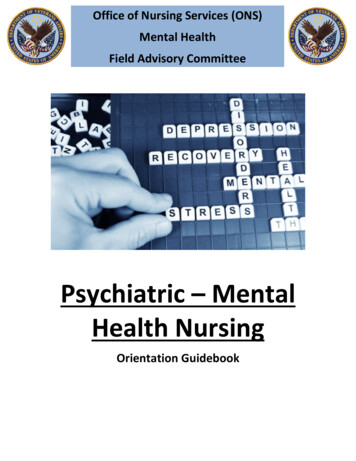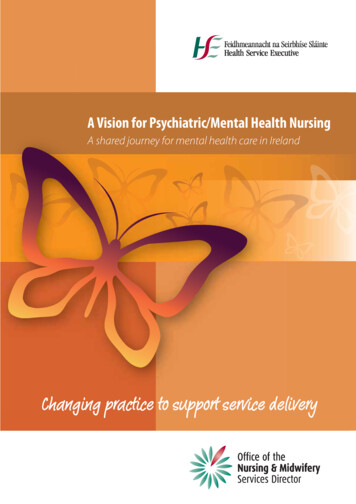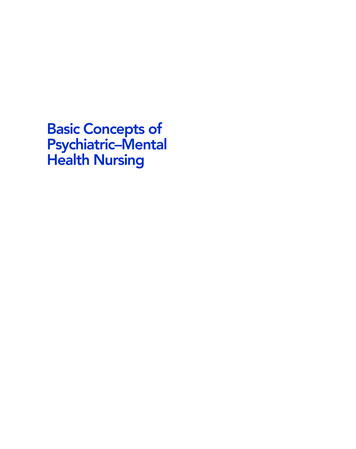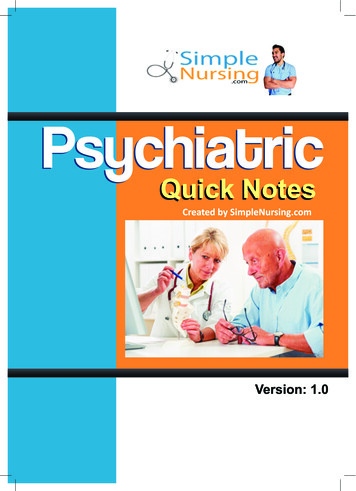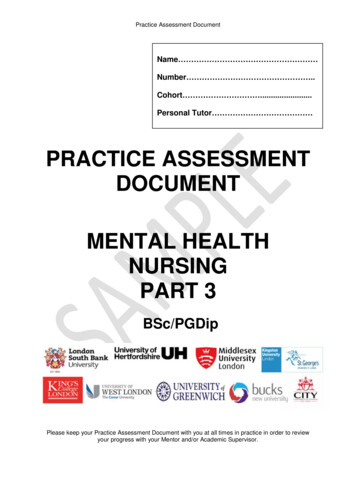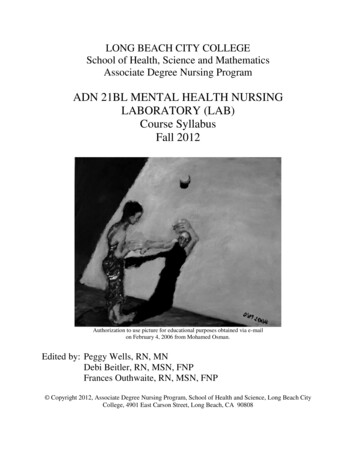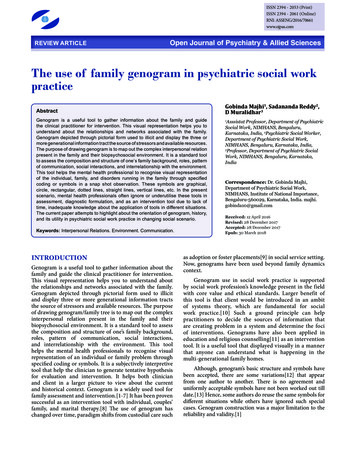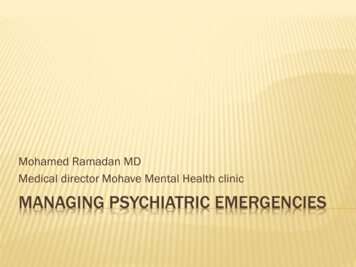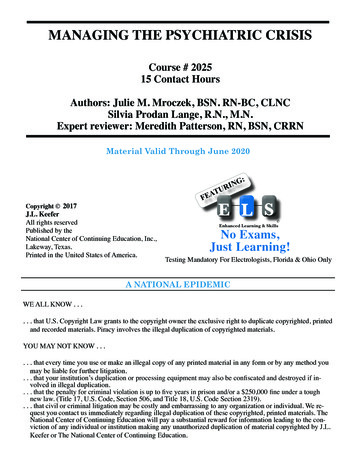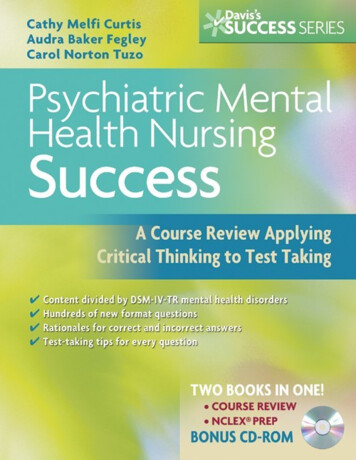
Transcription
Psychiatric MentalHealth NursingSuccessA Course Review Applying CriticalThinking to Test Taking
Cathy Melfi Curtis, MSN, RN-BCPsychiatric Mental Health NurseTrident Technical CollegeCharleston, South CarolinaAudra Baker Fegley, MSN, APRN-BCPsychiatric Mental Health Nurse PractitionerTrident Technical CollegeCharleston, South CarolinaCarol Norton Tuzo, MSN, RN-BCPsychiatric Mental Health NurseTrident Technical CollegeCharleston, South Carolina
F. A. DAVIS COMPANY PhiladelphiaF. A. Davis Company1915 Arch StreetPhiladelphia, PA 19103www.fadavis.comCopyright 2009 by F. A. Davis CompanyCopyright 2009 by F. A. Davis Company. All rights reserved. This book is protected bycopyright. No part of it may be reproduced, stored in a retrieval system, or transmitted in anyform or by any means, electronic, mechanical, photocopying, recording, or otherwise, withoutwritten permission from the publisher.Printed in the United States of AmericaLast digit indicates print number: 10 9 8 7 6 5 4 3 2 1Publisher, Nursing: Robert G. MartoneDirector of Content Development: Darlene D. PedersenProject Editor: Padraic J. MaroneyDesign and Illustration Manager: Carolyn O’BrienAs new scientific information becomes available through basic and clinical research,recommended treatments and drug therapies undergo changes. The author(s) and publisherhave done everything possible to make this book accurate, up to date, and in accord withaccepted standards at the time of publication. The author(s), editors, and publisher are notresponsible for errors or omissions or for consequences from application of the book, and makeno warranty, expressed or implied, in regard to the contents of the book. Any practicedescribed in this book should be applied by the reader in accordance with professionalstandards of care used in regard to the unique circumstances that may apply in each situation.The reader is advised always to check product information (package inserts) for changes andnew information regarding dose and contraindications before administering any drug. Cautionis especially urged when using new or infrequently ordered drugs.Authorization to photocopy items for internal or personal use, or the internal or personal use ofspecific clients, is granted by F. A. Davis Company for users registered with the CopyrightClearance Center (CCC) Transactional Reporting Service, provided that the fee of .10 per copyis paid directly to CCC, 222 Rosewood Drive, Danvers, MA 01923. For those organizations thathave been granted a photocopy license by CCC, a separate system of payment has beenarranged. The fee code for users of the Transactional Reporting Service is: 8036-1169-2/04 0 .10.The authors dedicate this book to the nursing students of Trident TechnicalCollege, whose eagerness to learn motivates us to teach mental healthnursing concepts in a way that is clear and readily understood. We have apassion for promoting mental health and hope to transfer this passionto our students by encouraging our students to critically think throughapplication test questions.We would like to thank Bob Martone, Alan Sorkowitz, and Padraic Maroneyfor giving us the opportunity to realize this goal. Working together hasincreased our knowledge, deepened ourfriendships, and reinforced our appreciation for good wine. A special thanksto Ramsay Hawkins for his patience during crisis situations, technicalexpertise, and memory sticks, all of which contributed to a successfulproject.—Cathy Melfi CurtisAudra FegleyCarol Norton TuzoI would like to dedicate this book to the memory of my sister, Sally. She wasalso a nursing instructor and would have appreciated the time and effortthat went into this book. Also, I would like to thank my children, Scott,
Emily, and Katie, who were supportive and patient during the projectdevelopment. I’m now available to babysit the grandchildren, Tessa, Bobby,Eve, Willie, and Addy.—Cathy Melfi CurtisThis book is dedicated to my loving husband, Damon, whose patience andunderstanding gave me strength; to my parents, Bonnie and Stan Baker,who listened attentively, always believed in me, and reminded me to laugh;and, lastly, to “the girls,” my fellow authors. I would never have wanted tobe on this journey without the both of you. Much love.—Audra FegleyI would like to dedicate this book to the memory of my husband, GeorgeLawrence Tuzo, whose support and encouragement saw me through nursingschool; also, to the memory of my parents, Astrid and Eric Norton, whoalways encouraged me to pursue my dreams and have fun along the way.Thanks also to my children, Steve, David, and Monique, for the manyuplifting phone calls. —Carol Norton Tuzo
ReviewersGeorgia Anderson, MSNProfessorSalt Lake Community CollegeSalt Lake City, UtahLinda L. Austin, BSN, MSN, PhDcAssistant ProfessorUniversity of North AlabamaFlorence, AlabamaBonnie Bar, RN, MS, AHN-CAssociate ProfessorUniversity of West GeorgiaCarrollton, GeorgiaBarbara Chamberlain, MSN, APN, C, CCRN, WCCCritical Care Advanced Practice NurseKennedy Health SystemTurnersville, New JerseyBeth Amy Clouse, RN, BSEdEducational Program ManagerMaryland General HospitalBaltimore, MarylandMartha M. Colvin, PhD, RN, CNSProfessor & Chair of Department of Undergraduate NursingGeorgia College and State UniversityMilledgeville, GeorgiaPerri-Anne Concialdi, RN, MSN, CNSInstructor IIAultman College of Nursing and Health SciencesCanton, OhioAaron D. Doyle, RN, MSN, CRRNNurse EducatorEastern Iowa Community CollegeClinton, Iowa
viiiviiREVIEWERSKendra Ericson, RN, MSNcNursing FacultyColumbia College of NursingMilwaukee, WisconsinJennifer Gambal, RN, BSN, CHPNAdjunct InstructorDeSales UniversityCenter Valley, PennsylvaniaMarybeth Gillis, MSNAssistant ProfessorElmira CollegeElmira, New YorkJoan Hoover, BSN, MSEdNursing InstructorButler Community CollegeEl Dorado, KansasKatharine M. Howard, MS, RN, BCNursing InstructorCharles E. Gregory School of Nursing/Raritan Bay MedicalCenter Perth Amboy, New JerseyMelissa Lickteig, EdD, RNAssistant ProfessorGeorgia Southern UniversityStatesboro, GeorgiaAngela Luciani, RN, BScN, MNNursing InstructorNunavut Arctic CollegeIqluit, Nunavut, CanadaPatricia A. Mahoney, MSN, RN, CNEPresidentNursEducator ConsultantsCarver, MassachusettsJudith Mariani, RN, BSN, MSN, ONCAssistant Professor/Adjunct Nursing InstructorMercer County Community CollegeWest Windsor, New Jersey
DeAnne Parrott, Med, MSN, CNEClinical InstructorOklahoma City UniversityOklahoma City, OklahomaREVIEWERSLinda C. Peterson, RN, EdD, NPPProfessorThe Sage CollegesTroy, New YorkChristine E. Pilon-Kacir, PhD, RNProfessorWinona State UniversityRochester, MinnesotaCarla E. Randall, PhDAssistant ProfessorUniversity of Southern MaineLewiston, MaineCherie Rebar, MSN, MBA, RN, FNP, NDAssistant ProfessorKettering College of Medical ArtsKettering, OhioDebra Renna, MSN, CCRNNursing InstructorKeiser UniversityFort Lauderdale, FloridaJudi Satereri, RN, MSNAssociate ProfessorSt. Olaf CollegeNorthfield, MinnesotaJana C. Saunder, PhD, RN, CSProfessorTexas Tech University Health Sciences CenterLubbock, TexasRosalee J. Seymour, EdD, RNProfessor EmeritusEast Tennessee State UniversityJohnson City, TennesseeAnna Shanks, RN, MN, ARNPProfessorix
Shoreline Community CollegeShoreline, WashingtonArdith Suddith, PhD, MSN, APRN-BCAssistant ProfessorUniversity of Louisiana at LafayetteLafayette, Louisiana
A. Fundamentals of Critical Thinking Related to Test Taking:The RACE Model . . . . . . . . . . . . . . . . . . . . . . . . . . . . . . . . . . . 1GUIDELINES FOR USING THIS BOOK . . . . . . . . . . . . . . . . . . . . . . . . . . . . . . . . . . . . 1PREPARING FOR LECTURE . . . . . . . . . . . . . . . . . . . . . . . . . . . . . . . . . . . . . . . . . . . . 2PREPARING FOR AN EXAMINATION. . . . . . . . . . . . . . . . . . . . . . . . . . . . . . . . . . . . . . 3TAKING THE EXAMINATION. . . . . . . . . . . . . . . . . . . . . . . . . . . . . . . . . . . . . . . . . . . . 4UNDERSTANDING THE TYPES OF NURSING QUESTIONS. . . . . . . . . . . . . . . . . . . . . . 5RACE MODEL: APPLICATION OF CRITICAL THINKING TO MULTIPLE-CHOICEQUESTIONS . . . . . . . . . . . . . . . . . . . . . . . . . . . . . . . . . . . . . . . . . . . . . . . . . . . . . . 6B. Basic Concepts in Psychiatric Mental Health Nursing. . . . . . . . . . 71. Mental Health/Mental Illness: Theoretical Concepts. . . . . . . . . . . 7PRACTICE QUESTIONS . . . . . . . . . . . . . . . . . . . . . . . . . . . . . . . . . . . . . . . . . . . . . . . 8Major Theoretical Models . . . . . . . . . . . . . . . . . . . . . . . . . . . . . . . . . . . . . . . . . . . .8Diagnostic and Statistical Manual of Mental Disorders IV-TR (DSM-IV-TR) . . . . . . . .11PRACTICE QUESTIONS ANSWERS AND RATIONALES. . . . . . . . . . . . . . . . . . . . . . . . 132. Psychiatric Nursing. . . . . . . . . . . . . . . . . . . . . . . . . . . . . . . . . 23PRACTICE QUESTIONS . . . . . . . . . . . . . . . . . . . . . . . . . . . . . . . . . . . . . . . . . . . . . . 24Mental Health Nursing . . . . . . . . . . . . . . . . . . . . . . . . . . . . . . . . . . . . . . . . . . . . .24 Role of theNurse . . . . . . . . . . . . . . . . . . . . . . . . . . . . . . . . . . . . . . . . . . . . . . . .25 NursingProcess . . . . . . . . . . . . . . . . . . . . . . . . . . . . . . . . . . . . . . . . . . . . . . . . .26 NurseClient Relationship . . . . . . . . . . . . . . . . . . . . . . . . . . . . . . . . . . . . . . . . . .28Transference/Countertransference . . . . . . . . . . . . . . . . . . . . . . . . . . . . . . . . . . . . .31PRACTICE QUESTIONS ANSWERS AND RATIONALES. . . . . . . . . . . . . . . . . . . . . . . . 323. Communication . . . . . . . . . . . . . . . . . . . . . . . . . . . . . . . . . . . 47PRACTICE QUESTIONS . . . . . . . . . . . . . . . . . . . . . . . . . . . . . . . . . . . . . . . . . . . . . . 48Therapeutic Communication Facilitators . . . . . . . . . . . . . . . . . . . . . . . . . . . . . . . .48Blocks to Therapeutic Communication . . . . . . . . . . . . . . . . . . . . . . . . . . . . . . . . .50Therapeutic Communication Interventions . . . . . . . . . . . . . . . . . . . . . . . . . . . . . . .50 NonverbalCommunication . . . . . . . . . . . . . . . . . . . . . . . . . . . . . . . . . . . . . . . . . .53Cultural Considerations . . . . . . . . . . . . . . . . . . . . . . . . . . . . . . . . . . . . . . . . . . . .54PRACTICE QUESTIONS ANSWERS AND RATIONALES. . . . . . . . . . . . . . . . . . . . . . . . 574. Psychopharmacology. . . . . . . . . . . . . . . . . . . . . . . . . . . . . . . . 71PRACTICE QUESTIONS . . . . . . . . . . . . . . . . . . . . . . . . . . . . . . . . . . . . . . . . . . . . . . 72Psychobiology . . . . . . . . . . . . . . . . . . . . . . . . . . . . . . . . . . . . . . . . . . . . . . . . . . .72Medication Administration Considerations in Mental Health . . . . . . . . . . . . . . . . . .73 Antianxiety Medications . . . . . . . . . . . . . . . . . . . . . . . . . . . . . . . . . . . . . . . . . . .
.73 Sedative/Hypnotic Medications . . . . . . . . . . . . . . . . . . . . . . . . . . . . . . . . . . . . . .74 Medications Used in the Treatment of AlcoholDependency . . . . . . . . . . . . . . . . . . .75 AntipsychoticMedications . . . . . . . . . . . . . . . . . . . . . . . . . . . . . . . . . . . . . . . . . .75Antidepressant Medications . . . . . . . . . . . . . . . . . . . . . . . . . . . . . . . . . . . . . . . . .77 Mood StabilizationMedications . . . . . . . . . . . . . . . . . . . . . . . . . . . . . . . . . . . . . .78 Attention-DeficitHyperactivity Disorder Medications . . . . . . . . . . . . . . . . . . . . . . . .79Medication Calculations . . . . . . . . . . . . . . . . . . . . . . . . . . . . . . . . . . . . . . . . . . . .80PRACTICE QUESTIONS ANSWERS AND RATIONALES. . . . . . . . . . . . . . . . . . . . . . . . 82xi
xiiCONTENTS5. Legal and EthicalConsiderations . . . . . . . . . . . . . . . . . . . . . . . 99PRACTICE QUESTIONS . . . . . . . . . . . . . . . . . . . . . . . . . . . . . . . . . . . . . . . . . . . . . 100Legal and Ethical Concepts . . . . . . . . . . . . . . . . . . . . . . . . . . . . . . . . . . . . . . . .100Safety Issues . . . . . . . . . . . . . . . . . . . . . . . . . . . . . . . . . . . . . . . . . . . . . . . . . .100Client Rights . . . . . . . . . . . . . . . . . . . . . . . . . . . . . . . . . . . . . . . . . . . . . . . . . . .101Voluntary and Involuntary Commitment . . . . . . . . . . . . . . . . . . . . . . . . . . . . . . . .102Confidentiality . . . . . . . . . . . . . . . . . . . . . . . . . . . . . . . . . . . . . . . . . . . . . . . . . .103Potential Liability . . . . . . . . . . . . . . . . . . . . . . . . . . . . . . . . . . . . . . . . . . . . . . .104Advanced Directives . . . . . . . . . . . . . . . . . . . . . . . . . . . . . . . . . . . . . . . . . . . . .104PRACTICE QUESTIONS ANSWERS AND RATIONALES. . . . . . . . . . . . . . . . . . . . . . . 1056. Stress Adaptation Throughout the LifeSpan . . . . . . . . . . . . . . 113PRACTICE QUESTIONS . . . . . . . . . . . . . . . . . . . . . . . . . . . . . . . . . . . . . . . . . . . . .114 Theory . . . . . . . . . . . . . . . . . . . . . . . . . . . . . . . . . . . . . . . . . . . . . . . . . . . . . .114 Ego Defense Mechanisms . . . . . . . . . . . . . . . . . . . . . . . . . . . . . . . . . . . . . . . .115 Responses toStress . . . . . . . . . . . . . . . . . . . . . . . . . . . . . . . . . . . . . . . . . . . . . .116 CrisisIntervention . . . . . . . . . . . . . . . . . . . . . . . . . . . . . . . . . . . . . . . . . . . . . . .117Safety Issues Related to Stress Adaptation . . . . . . . . . . . . . . . . . . . . . . . . . . . . .118PRACTICE QUESTIONS ANSWERS AND RATIONALES. . . . . . . . . . . . . . . . . . . . . . . 120C.Management of Care for Individuals with PsychiatricDisorders . . . . . . . . . . . . . . . . . . . . . . . . . . . . . . . . . . . . . . .1317. Anxiety and SleepDisorders. . . . . . . . . . . . . . . . . . . . . . . . . . 131PRACTICE QUESTIONS . . . . . . . . . . . . . . . . . . . . . . . . . . . . . . . . . . . . . . . . . . . . . 132Theory . . . . . . . . . . . . . . . . . . . . . . . . . . . . . . . . . . . . . . . . . . . . . . . . . . . . . . .132Defense Mechanisms . . . . . . . . . . . . . . . . . . . . . . . . . . . . . . . . . . . . . . . . . . . . .133Nursing Process—Assessment . . . . . . . . . . . . . . . . . . . . . . . . . . . . . . . . . . . . . .133Nursing Process—Diagnosis . . . . . . . . . . . . . . . . . . . . . . . . . . . . . . . . . . . . . . . .135Nursing Process—Planning . . . . . . . . . . . . . . . . . . . . . . . . . . . . . . . . . . . . . . . .136Nursing Process—Intervention . . . . . . . . . . . . . . . . . . . . . . . . . . . . . . . . . . . . . .137Nursing Process—Evaluation . . . . . . . . . . . . . . . . . . . . . . . . . . . . . . . . . . . . . . .139Psychopharmacology . . . . . . . . . . . . . . . . . . . . . . . . . . . . . . . . . . . . . . . . . . . . .139PRACTICE QUESTIONS ANSWERS AND RATIONALES. . . . . . . . . . . . . . . . . . . . . . . 1408. Psychophysiological and Somatoform Disorders . . . . . . . . . . . 155PRACTICE QUESTIONS . . . . . . . . . . . . . . . . . . . . . . . . . . . . . . . . . . . . . . . . . . . . . 156Theory . . . . . . . . . . . . . . . . . . . . . . . . . . . . . . . . . . . . . . . . . . . . . . . . . . . . . . .156Nursing Process—Assessment . . . . . . . . . . . . . . . . . . . . . . . . . . . . . . . . . . . . . .156Nursing Process—Diagnosis . . . . . . . . . . . . . . . . . . . . . . . . . . . . . . . . . . . . . . . .157Nursing Process—Planning . . . . . . . . . . . . . . . . . . . . . . . . . . . . . . . . . . . . . . . .158Nursing Process—Intervention . . . . . . . . . . . . . . . . . . . . . . . . . . . . . . . . . . . . . .158Nursing Process—Evaluation . . . . . . . . . . . . . . . . . . . . . . . . . . . . . . . . . . . . . . .159Psychopharmacology . . . . . . . . . . . . . . . . . . . . . . . . . . . . . . . . . . . . . . . . . . . . .160PRACTICE QUESTIONS ANSWERS AND RATIONALES. . . . . . . . . . . . . . . . . . . . . . . 161
9. Delirium, Dementia, HIV, and Amnestic Disorders . . . . . . . . . 169PRACTICE QUESTIONS . . . . . . . . . . . . . . . . . . . . . . . . . . . . . . . . . . . . . . . . . . . . . 170Theory . . . . . . . . . . . . . . . . . . . . . . . . . . . . . . . . . . . . . . . . . . . . . . . . . . . . . . .170Nursing Process—Assessment . . . . . . . . . . . . . . . . . . . . . . . . . . . . . . . . . . . . . .170Nursing Process—Diagnosis . . . . . . . . . . . . . . . . . . . . . . . . . . . . . . . . . . . . . . . .171Nursing Process—Planning . . . . . . . . . . . . . . . . . . . . . . . . . . . . . . . . . . . . . . . .172Nursing Process—Intervention . . . . . . . . . . . . . . . . . . . . . . . . . . . . . . . . . . . . . .172Nursing Process—Evaluation . . . . . . . . . . . . . . . . . . . . . . . . . . . . . . . . . . . . . . .173Psychopharmacology . . . . . . . . . . . . . . . . . . . . . . . . . . . . . . . . . . . . . . . . . . . . .173PRACTICE QUESTIONS ANSWERS AND RATIONALES. . . . . . . . . . . . . . . . . . . . . . . 174CONTENTSxiii10. Eating Disorders . . . . . . . . . . . . . . . . . . . . . . . . . . . . . . . . . . 183PRACTICE QUESTIONS . . . . . . . . . . . . . . . . . . . . . . . . . . . . . . . . . . . . . . . . . . . . . 184Theory . . . . . . . . . . . . . . . . . . . . . . . . . . . . . . . . . . . . . . . . . . . . . . . . . . . . . . .184Nursing Process—Assessment . . . . . . . . . . . . . . . . . . . . . . . . . . . . . . . . . . . . . .184Nursing Process—Diagnosis . . . . . . . . . . . . . . . . . . . . . . . . . . . . . . . . . . . . . . . .186Nursing Process—Planning . . . . . . . . . . . . . . . . . . . . . . . . . . . . . . . . . . . . . . . .186Nursing Process—Intervention . . . . . . . . . . . . . . . . . . . . . . . . . . . . . . . . . . . . . .186Nursing Process—Evaluation . . . . . . . . . . . . . . . . . . . . . . . . . . . . . . . . . . . . . . .187Psychopharmacology . . . . . . . . . . . . . . . . . . . . . . . . . . . . . . . . . . . . . . . . . . . . .188PRACTICE QUESTIONS ANSWERS AND RATIONALES. . . . . . . . . . . . . . . . . . . . . . . 18911. Personality Disorders. . . . . . . . . . . . . . . . . . . . . . . . . . . . . . . 199PRACTICE QUESTIONS . . . . . . . . . . . . . . . . . . . . . . . . . . . . . . . . . . . . . . . . . . . . . 200Theory . . . . . . . . . . . . . . . . . . . . . . . . . . . . . . . . . . . . . . . . . . . . . . . . . . . . . . .200Defense Mechanisms . . . . . . . . . . . . . . . . . . . . . . . . . . . . . . . . . . . . . . . . . . . . .200Nursing Process—Assessment . . . . . . . . . . . . . . . . . . . . . . . . . . . . . . . . . . . . . .201Nursing Process—Diagnosis . . . . . . . . . . . . . . . . . . . . . . . . . . . . . . . . . . . . . . . .203Nursing Process—Planning . . . . . . . . . . . . . . . . . . . . . . . . . . . . . . . . . . . . . . . .204Nursing Process—Intervention . . . . . . . . . . . . . . . . . . . . . . . . . . . . . . . . . . . . . .205Nursing Process—Evaluation . . . . . . . . . . . . . . . . . . . . . . . . . . . . . . . . . . . . . . .206Psychopharmacology . . . . . . . . . . . . . . . . . . . . . . . . . . . . . . . . . . . . . . . . . . . . .207PRACTICE QUESTIONS ANSWERS AND RATIONALES. . . . . . . . . . . . . . . . . . . . . . . 20812. Dissociative and Sexual/Gender Identity Disorders . . . . . . . . . .225PRACTICE QUESTIONS . . . . . . . . . . . . . . . . . . . . . . . . . . . . . . . . . . . . . . . . . . . . . 226Theory . . . . . . . . . . . . . . . . . . . . . . . . . . . . . . . . . . . . . . . . . . . . . . . . . . . . . . .226Nursing Process—Assessment . . . . . . . . . . . . . . . . . . . . . . . . . . . . . . . . . . . . . .226Nursing Process—Diagnosis . . . . . . . . . . . . . . . . . . . . . . . . . . . . . . . . . . . . . . . .227Nursing Process—Planning . . . . . . . . . . . . . . .
DeSales University Center Valley, Pennsylvania Marybeth Gillis, MSN Assistant Professor Elmira College Elmira, New York Joan Hoover, BSN, MSEd . Nursing Instructor Keiser University Fort Lauderdale, Florida Judi Satereri, RN, MSN Associate Professor St. Olaf C

